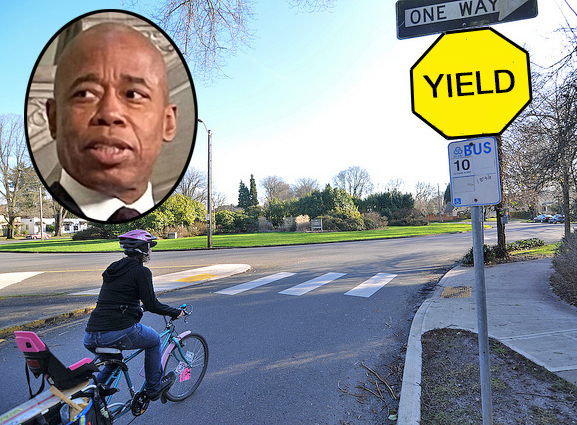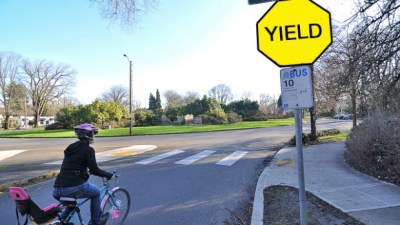THE SLOW WALK: What Happened to Those Cyclist-Friendly Rules?

Two city rule changes that would boost cycling and make bike riders less likely to be harassed by police officers are stuck in slow motion — and the timing is particularly troubling, advocates say, because another rule that makes cycling more difficult just went into affect last month with great fanfare.
Mayor Adams made headlines in January when he announced that the NYPD would aggressively enforce a late-de Blasio-era rule that requires drivers — and cyclists — to come to a full stop at non-signalized crosswalks if there is a pedestrian seeking to cross, and then to wait until the pedestrian has gotten all the way to the other sidewalk before starting up again.
Lost in the coverage of Hizzoner’s announcement was the fact that the new rule was one of a spate or regulatory changes sought since 2020 by the Department of Transportation — yet two rules that would have made life easier for cyclists, and encouraged more bike riding by the public, were not implemented.
The rule that now requires cyclists to stop for pedestrians and then wait for them to get fully to the other side of the road was contained in the DOT’s “regulatory agenda” for fiscal year 2021 (which corresponds to July 1, 2020-June 30, 2021).
Meanwhile, two rule changes long sought by cyclists and mentioned in the same agenda document remain in a silent limbo. They are rules to:
- allow cyclists to right turns “during a steady red” light after a full stop and if no pedestrians are around (originally slated to be implemented between April and June, 2021). According to the DOT, this rule change would “provid[e] cyclists an opportunity to turn ahead of turning traffic allowing them to avoid the blind spot of turning vehicles and the ‘hook’ type of crash, one of the most common threats to cyclists at intersections.”
- allow cyclists to roll through red lights or stop signs at “top of the T” intersections (intersections with no cross traffic), as long as there are no pedestrians. This rule change would formalize “existing behavior where there is no history of crashes,” the agency said. It was originally slated to be implemented between April and June, 2021). The DOT said this rule change “allows cyclists to maintain momentum which saves energy and reduces trip time, making cycling more attractive.”
But last week, a spokesman for DOT told Streetsblog that, unlike the enforcement regulation that Adams announced, neither of these rule changes had been put on the public hearing schedule, which is a required step for the agency to implement the changes. The agency declined to let Streetsblog interview an official with direct knowledge of the rules or why they were delayed. The rules were reposted in the agency’s FY2022 regulatory agenda, with the target implementation dates between April and June of this year, an implausible timeline.
“We will have more to say at forthcoming public hearings, once they are scheduled,” said the spokesman, Vin Barone.
Activists weren’t pleased.
“Allowing people on bikes to make a right turn on red, or roll through the safe side of a ‘T’ intersection, when pedestrians are absent is about as common-sense as you can get,” said Eric McClure of StreetsPAC, the only street safety political action committee in town. “Neither maneuver endangers anyone, and both make getting around by bike just a little bit easier. It’s disappointing that these safe, straightforward adjustments to the rules have yet to be implemented. DOT should hold a hearing and make these changes ASAP.”
Jon Orcutt of Bike New York promised action.
“We’ll be asking the Adams administration to dust these draft rule changes off and implement them,” he said.
The irony of the delay in carrying out the pro-cycling rule changes is that the other rule that Adams hyped last month was specifically written to allow police to target cyclists. Before the rule change, the law focused specifically on drivers, not cyclists:
When traffic control signals or pedestrian control signals are not in place or not in operation, the operator of a vehicle shall yield the right of way to a pedestrian crossing a roadway within a crosswalk when the pedestrian is in the path of the vehicle or is approaching so closely thereto as to be in danger.
The rule change, however, put cyclists in the crosshairs (new language is in bold; deleted language is in brackets):
When traffic control signals or pedestrian control signals are not in place or not in operation, [the] any operator of a vehicle or operator of a bicycle [shall yield the right of way to] must stop for a pedestrian crossing a roadway within a crosswalk [when the pedestrian is in the path of the vehicle or is approaching so closely thereto as to be in danger]. Such operators of vehicles and operators of bicycles in any lane of travel must stop and remain stopped for a pedestrian in crosswalk until such pedestrian crosses a roadway.
DOT Commissioner Ydanis Rodriguez told Streetsblog that the rule change would be reconsidered if cyclists report that they are being singled out for inappropriate enforcement.

